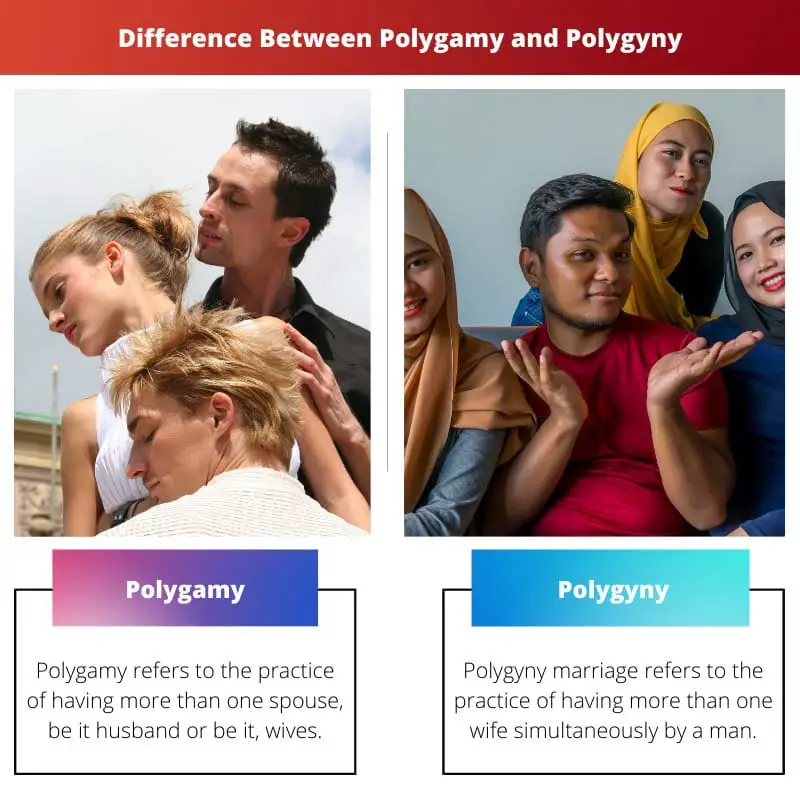Polygamy refers to the practice of having multiple spouses simultaneously, be it wives or be it, husbands. But most people assume that polygamy is marrying multiple women by a man.
Key Takeaways
- Polygamy is a marriage that involves multiple spouses.
- Polygyny is a form of polygamy where a man is married to multiple wives.
- Polygyny is a specific form of polygamy that only involves multiple wives.
Polygamy vs Polygyny
Polygamy is the practice of having more than one spouse simultaneously. Polygamy can take different forms, including polygyny and polyandry, depending on the gender of the spouses involved. Polygyny is a specific form of polygamy in which a man has multiple wives. This is the most common form of polygamy throughout history and across cultures.

Polygamy is the practice of having multiple spouses simultaneously, be it husbands or be it, wives. The word ‘polygamy’ is derived from two Greek words- ‘polys’, which means ‘many, and ‘gamos’, which means marriage.
Polygyny is a specific type of polygamy. Polygyny is the most common type of polygamy, where a man is simultaneously married to more than one female.
Comparison Table
| Parameters of Comparison | Polygamy | Polygyny |
|---|---|---|
| Definition | Polygamy refers to the practice of having more than one spouse, be it husband or be it, wives. | Polygyny marriage refers to the practice of having more than one wife simultaneously by a man. |
| Derived from | The word ‘polygamy’ is derived from two Greek words. They are ‘polys’ which means many and ‘gamos’ which means marriage. | The word ‘polygyny’ is derived from two Greek words- ‘polys’ which means many and ‘gyne’ which means wife or woman. |
| Types | There are three types of polygamy. They are polygyny, polyandry and group marriage. Among these types, polygyny is the most popular marriage type. | There are three types of polygyny. They are Sororal polygyny, non-sororal polygyny and levirate marriage. |
| Correlation | Not every polygamy marriage is a polygyny marriage. There are other types of polygamy marriages like polyandry marriage and group marriage. | Every polygyny marriage is polygamy. Polygyny is a type of polygamy marriage where a man is married to multiple wives simultaneously. |
| Acceptance | Not all kinds of polygamy marriage are accepted by the Quran. Quran only accepts polygyny marriage under certain circumstances and conditions. | Quran allows every kind of polygyny marriage under certain circumstances and conditions. |
What is Polygamy?
Polygamy is the practice of having multiple spouses simultaneously, be it husbands or be it, wives. The word ‘polygamy’ is derived from two Greek words- ‘polys’, which means ‘many and ‘gamos’, which means marriage.
Polygamy has been practised by many societies under certain circumstances and conditions. The biblical King named Solomon is said to have 300 queens.
There are mainly three types of polygamy marriage – polygyny marriage, polyandry marriage and group marriage. Polygyny marriage is the practice of having multiple wives by a man simultaneously.
There are two types of polyandry marriage- fraternal polyandry and non-fraternal polyandry. In fraternal marriage, the husbands are the brothers and belong to a common family.
The most common polygamy marriage is the polygyny marriage. Polygamy marriage is relatively common in West African countries and some Muslim countries.

What is Polygyny?
Polygyny is a specific type of polygamy. Polygyny is the most common type of polygamy, where a man is married to more than one female simultaneously.
Polygyny marriage is accepted in many Muslim countries, and Quran allows every kind of polygyny marriage under certain circumstances and conditions.
Contemporary Christians do not accept polygyny marriage. In the African continent, polygyny is mostly practised. One of the main reasons for this is the existing gender gap in African countries which is a result of the slave trade.
There are three types of polygyny. They are Sororal polygyny, non-sororal polygyny and levirate marriage. Sororal marriage is the practice of having multiple wives who are sisters.

Main Differences Between Polygamy and Polygyny
- Not every polygamy marriage is a polygyny marriage. There are other types of polygamy marriages, like polyandry marriage and group marriage. But every polygyny marriage is polygamy.
- Not all kinds of polygamy marriage are accepted by the Quran. Quran only accepts polygyny marriage under certain circumstances and conditions.


The article effectively differentiates between polygamy and polygyny, shedding light on their distinct characteristics. It’s a well-researched piece.
I completely agree. The article tackles a complex topic with intellectual rigor.
This is a clear and concise explanation of the difference between polygamy and polygyny. It’s interesting to know that not all polygamy marriages are polygyny.
Yes, the article provides a very informative comparison of the two practices.
The mention of Quranic acceptance of polygyny under specific conditions is an intriguing aspect of the discussion. The article presents a comprehensive overview of the topic.
I appreciate the theological dimension the article explores.
Yes, the article’s coverage of religious perspectives on polygyny provides valuable insight.
The explanation of the types of polygamy and polygyny is well-defined. It’s fascinating to learn about their historical and cultural significance.
Agreed. The article is very informative about the topic.
I appreciate the comparison table included in the article. It makes it easier to understand the key differences between polygamy and polygyny.
The historical context of polygamy and polygyny, including the biblical reference, adds depth to the article’s content.
Absolutely. It’s important to understand the cultural and historical significance of these practices.
The distinction between different polygamy marriages is well articulated. The article provides a thorough understanding of this complex topic.
The differentiation between the types of polygyny is particularly enlightening.
I agree. The article’s clarity is commendable.
The article’s discussion of contemporary perspectives on polygyny, such as its acceptance in different cultures, broadens the scope of the topic.
Absolutely. The cultural context of polygyny is an important aspect of the article’s analysis.
The discussion of contemporary practices offers valuable insights into the complexities of polygyny.
Great article.
The explanation of the types of polyandry and their cultural prevalence adds an interesting layer to the conversation.
Indeed. The article’s exploration of different forms of polygamy is thought-provoking.
The article’s coverage of polyandry contributes to a comprehensive understanding of alternative marriage practices.
The references provided in the article add credibility to the information. It’s great to see scholarly sources being used.
The comparison of accepted polygyny marriages in different cultures adds an interesting dimension to the discussion.
Absolutely. The scholarly references contribute to the intellectual depth of the article.